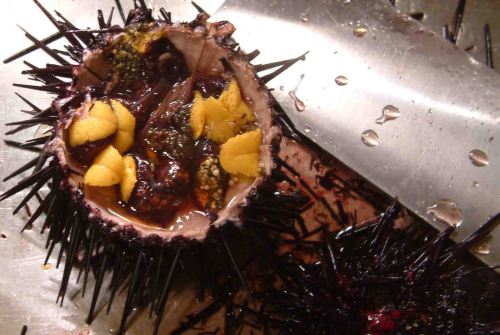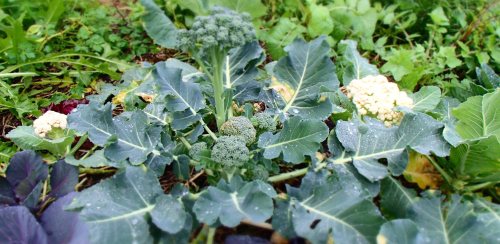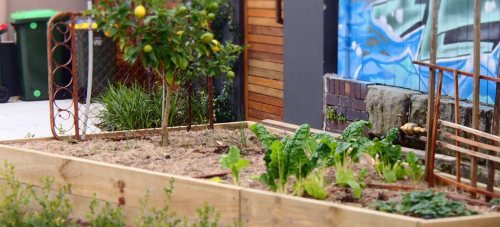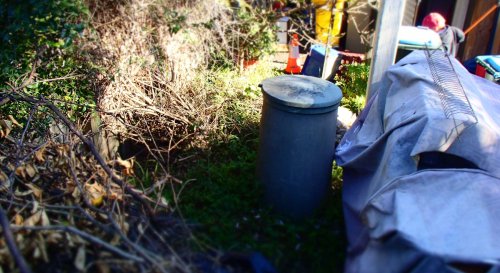You may notice from the timing of the archives for this blog that things slowed down a little on the foraging front, at least with regard to writing about it. I’m still very much at it, but at the same time I’ve been domesticated. I came to own a home and it came with a modest piece of sand dune out the back, which a year and several tonnes of compost later is the start of a food garden. There are fruit trees, thriving beds of vegetables, chickens, a dog and a beehive ready to populate this spring. Some of my foraging has even turned a little domestic – like valuing foraged molluscs for the shell grit I can crush for the chooks as well as the meat for me, using kelp stems off the beach for dog chew toys, and scavenging free mulch and cow manure for the garden beds. The last time I foraged native spinach (Tetragonia tetragonioides), it was to replant it in my garden – and that is entirely definitive of domestication.

My fellow domesticates: 2 Leghorn crosses, 2 Australorps, 2 Rhode Island Reds (Gallus gallus domesticus) amid a future food forest and feeding on vegie waste; and ‘Bugle’, the Brittany, hunting dog (Canis familiaris) in training
Working away in my changed circumstances, I have come to a recent realisation of how much more foraging and agriculture have in common than either of them have in common with the lifestyle of simply buying all your food. The ‘us and them’ of the standard view is of ‘us’ as modern western society arm-in-arm with agriculture as distinct from a foraging ‘them’ of either the past or the primitive. My ‘domestication’ really has been revolutionary in one sense, but in some ways it has also changed things very little. I no longer really forage greens, but grow them instead; even the edible garden weeds get a miss, although partly because right now in winter/spring it is mostly chickweed (Stellaria media) and it is such a big hit with the chooks. I’m just as inclined towards fishing and hunting; and foraged fruit retains the same appeal or maybe more – partly because my trees are all just one year or less in the ground and give me very little. The autumn harvest of pine mushrooms (Lactarius deliciosus) will hopefully always be a firm fixture. When I think about, it’s really just more like old-fashioned country foodways. The growing and the foraging are part of the same package. Regardless of who is ‘us’ and who is ‘them’, the two parties in the modern western world can be divided into those who very much want to get their hands dirty while bringing in their food and those who only really trust it wrapped in plastic in exchange for money.
I’ve previously discussed (e.g. here and here) how there is the concept of a continuum of foraging to farming along which people have shifted through history, incrementally between individuals and between generations, and not always in the same direction. Perhaps this foraging-to-farming transition thing doesn’t mean so much to you; and perhaps I make too much of it because as an archaeologist it is viewed as the process that pretty much defines the transformation to human modernity. But for someone like me for whom it is kind of a big deal, it is then also a very big deal to realise that to just end up standing there at the end of the day in your work clothes in a queue at Woolies or Coles (Walmart, Aldi, Sainsburys, depending on where you are) is to exist in a world that (as far as your personal engagement goes) has left the continuum altogether. Sure, the production of the food is still obviously on it, perhaps often at the perverse end of heavily industrialised agriculture (with battery chickens as the ultimate perversity), but the individual consumer is not. I think that I embraced foraging so as to have as much of an actual engagement with the reality of food as I could, and now grow for precisely the same reason.
Opportunism is central to the success of humanity. I now have the opportunity to grow more than I ever did before, but still I will not readily pass up the opportunity for a good forage. Nonetheless, the same intrinsically human opportunism is what puts people in the supermarket queue, finding that they are able with just a small part of the cash from their labour to bring home far more food than they could possibly eat. In that context, we foragers and growers are wasting our time – what sort of fool spends ten days to save a couple of bucks on mustard? But ‘agency’, the ability and freedom to make choices, is also central to humanity.
For me, the ideal of paid working life is not to be able to buy the things that I might otherwise forage or grow, but to buy the time and the ability to be in a place to do that foraging and growing. That is my choice, and I am sure that I spend more money on it than the equivalent cost of the food. I can’t make enough mustard to get me to New Zealand to fish for all too occasional trout, but I do paid work for that (and, importantly, I enjoy it). There is also a mortgage now; and it hurts, so one thing that I need to get out of that is a garden full of veg; not to help pay the mortgage, but to justify it. And that leads to a really key thing that I have realised about domestication and the shift from foraging to farming – whether on the scale of human history or my own small personal experience: it is not just about where the food comes from, but also what people chain themselves to in order to get it. The anthropologist Marshall Sahlins once described foragers as ‘the original affluent society’, referring to the fact that they might easily meet all their wants and needs, partly because those needs may be relatively few; whereas someone with infinite modern wants never can, and can therefore never be truly affluent at all. I admit that it is an unresolved logic, but still not without merit, that the desire to forage and grow your own food can somehow break the loop while living in a modern world with seemingly easy supermarket options. Taking ten days to make half a cup of mustard really may be the secret to affluence after all. I may have been domesticated, I may even have hooked up to one more chain, but I’m still not quite caged yet.


















